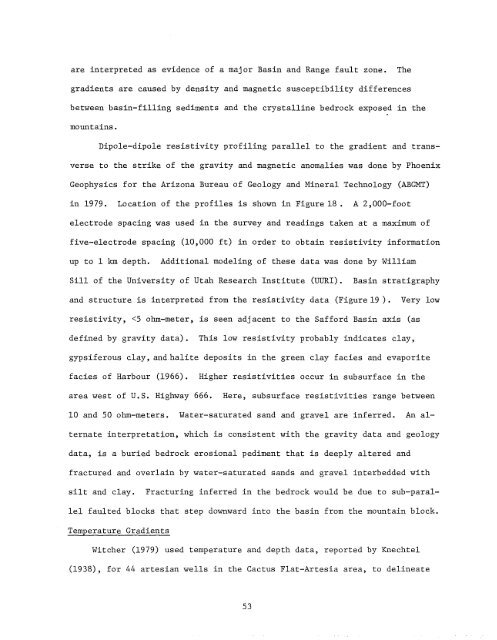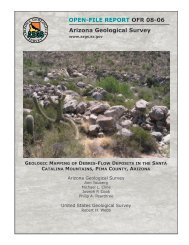geothermal resource potential of the safford-san simon basin, arizona
geothermal resource potential of the safford-san simon basin, arizona
geothermal resource potential of the safford-san simon basin, arizona
You also want an ePaper? Increase the reach of your titles
YUMPU automatically turns print PDFs into web optimized ePapers that Google loves.
are interpreted as evidence <strong>of</strong> a major Basin and Range fault zone.<br />
The<br />
gradients are caused by density and magnetic susceptibility differences<br />
between <strong>basin</strong>-filling sediments and <strong>the</strong> crystalline bedrock exposed in <strong>the</strong><br />
mountains.<br />
Dipole-dipole resistivity pr<strong>of</strong>iling parallel to <strong>the</strong> gradient and transverse<br />
to <strong>the</strong> strike <strong>of</strong> <strong>the</strong> gravity and magnetic anomalies was done by Phoenix<br />
Geophysics for <strong>the</strong> Arizona Bureau <strong>of</strong> Geology and Mineral Technology (ABGMT)<br />
in 1979. Location <strong>of</strong> <strong>the</strong> pr<strong>of</strong>iles is shown in Figure 18. A 2,000-foot<br />
electrode spacing was used in <strong>the</strong> survey and readings taken at a maximum <strong>of</strong><br />
five-electrode spacing (10,000 ft) in order to obtain resistivity information<br />
up to 1 km depth.<br />
Additional modeling <strong>of</strong> <strong>the</strong>se data was done by William<br />
Sill <strong>of</strong> <strong>the</strong> University <strong>of</strong> Utah Research Institute (UURI).<br />
Basin stratigraphy<br />
and structure is interpreted from <strong>the</strong> resistivity data (Figure 19 ).<br />
Very low<br />
resistivity,

















